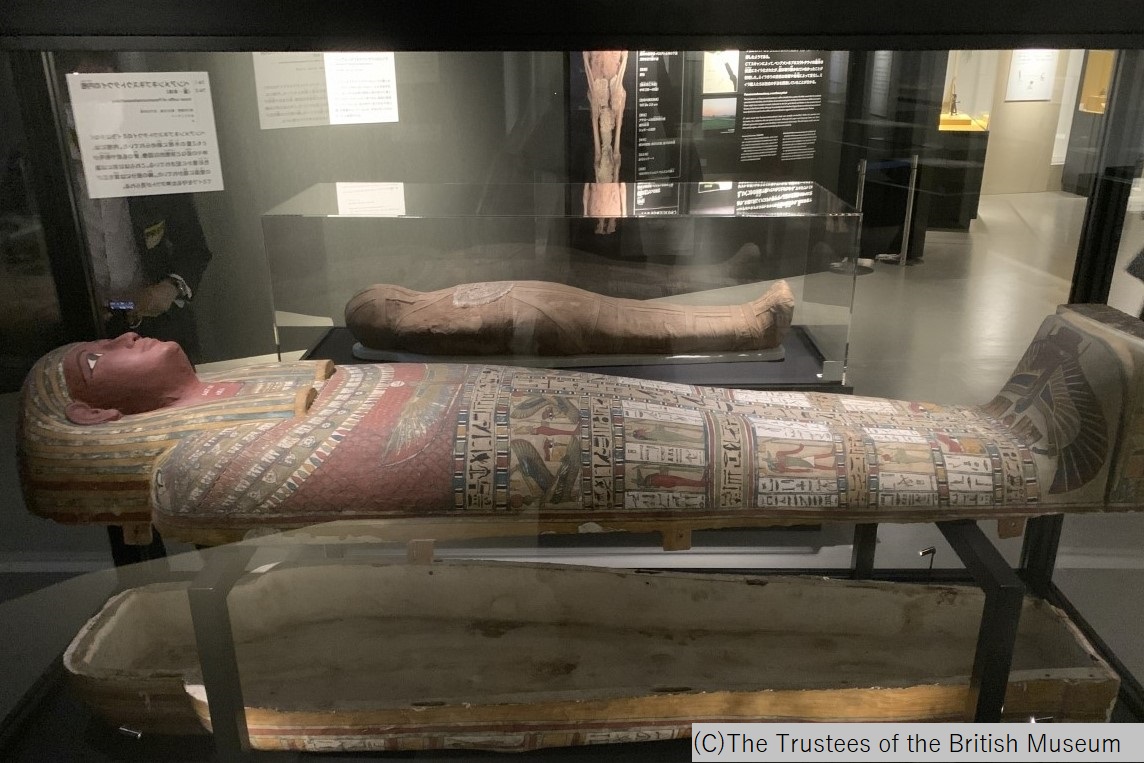
Known as a cultural heritage hall of fame, the British Museum has led the world in the study of ancient Egyptian civilization. A special exhibition "British Museum Mummy Exhibition: Six Ancient Egyptian Stories" will be held at the National Science Museum in Ueno, Tokyo, focusing on the six mummies carefully selected by the museum, based on the latest research results. It is being held.
* The session is from October 14, 2021 (Thursday) to January 12, 2022 (Wednesday).
We covered the press preview held on the day of the opening, so we will report on the situation at the venue.
* The photos shown are taken with special permission, and the general public is prohibited from taking them.
* The photo is often reflected on the glass due to the equipment. Please note that some parts may be difficult to see.
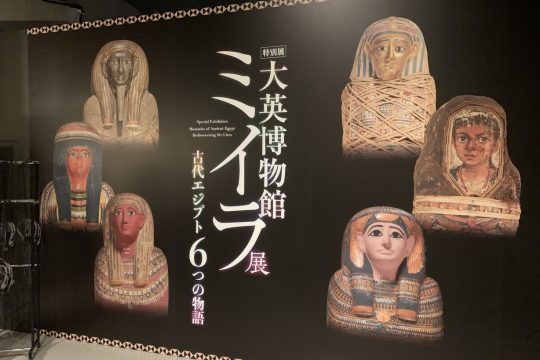
Entrance visual

Venue scenery
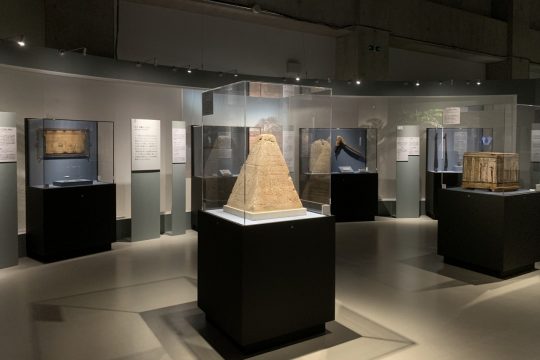
Venue scenery
An ancient Egyptian figure unraveling from six mummies
Even if they die in this world, their existence does not end, and the ancient Egyptians, who had the view of life and death that they would be resurrected in the afterlife, developed the technique of making mummies in order to preserve the body necessary for regeneration. In the special exhibition "British Museum Mummy Exhibition: Six Stories of Ancient Egypt", the mummies of six people who lived in ancient Egypt from about 800 BC to about 100 BC are exhibited.
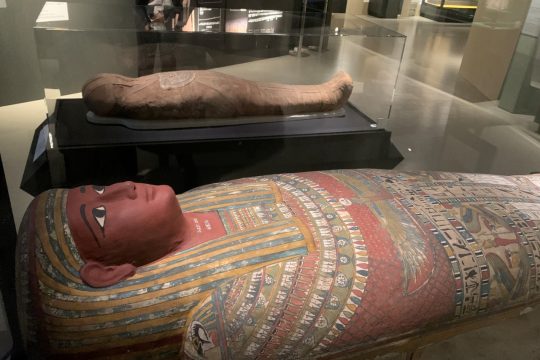
"Pen Amen Nebnes Uttaui Inner Coffin" and "Pen Amen Nebnes Uttaui Mummy" (C) The Trustees of the British Museum
The bright decoration of the casket is eye-catching. On the chest is the image of the god Nut, who spreads his wings as if to protect him.
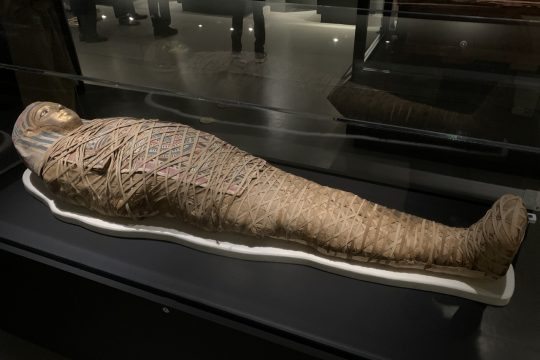
"Young Men's Mummy" (C) The Trustees of the British Museum
"Amen Iri Ireto Thebes officials" "Nesper Ennebu Thebes priests" "Pen Amen Nebnes Uttaui lower Egyptian priests" "Takenemet Thebes married women" "Hawara children" "Young men of the Greco-Roman era" Six mummies with different positions, ages, and times of life.
The interior is restored with a high-precision 3D construction image created based on a large amount of CT scan images of about 7,000 images per body. Introducing life aspects such as health condition, medical history such as cancer and arteriosclerosis, and age of death that could not be understood from textual information such as inscriptions, along with about 250 abundant exhibits.
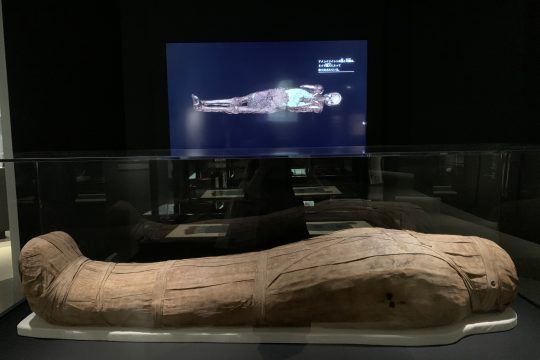
"Amen Iriireto Mummy" (C) The Trustees of the British Museum
In the 3D construction video, detailed information on the inside is explained, as well as the clarified medical conditions during life.
Of particular interest to the benefit of CT scans is the priest of the Karnak Temple, Nesperennebuu, which was the most important religious facility in Thebes (now Luxor) around 800 BC in the Third Intermediate Period, around 800 BC. It's a mummy.
Various amulets and magical trinkets are placed on the mummy to protect the dead and help them gain eternal life. A CT scan revealed that the Nesper Ennebu mummies remained unopened, and their detailed layout and materials were revealed.

"Mummy of Nesper Ennebu" (C) The Trustees of the British Museum

Amulets and jewelry duplicated by a 3D printer (C) The Trustees of the British Museum
The video shows the location of the amulets and jewelry placed on the mummy, but I was surprised that they were placed not only on the skin and between the bandages, but also inside the body. It is said that amulets and accessories have important meaning not only in shape and letters but also in position, and it is a result of technological improvement that such inside information is known without damaging the relics.
Many of the items inside are printed in 3D and displayed, so please compare them with the images and appreciate them.
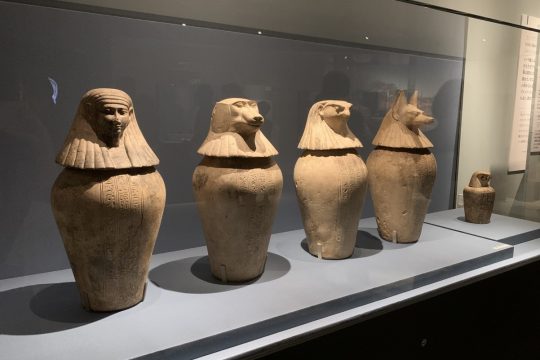
"The Trustees of the British Museum" (C) The Trustees of the British Museum
Many relics showing the ancient Egyptian beliefs related to funerals, including mummification, are exhibited in this exhibition, but an example that clearly shows the form of one belief is the "Canopic jar".
The perishable internal organs are removed when making mummies, but the liver, lungs, stomach, and intestines are considered to be particularly important for regeneration, and they are carefully protected by a container called the Canopic jar, which is modeled after the four sons of Horus. rice field.
Imagine that the brain is also stored somewhere on the premise of resurrection, but it seems that the brain was abandoned in the process of making a mummy because its function was not understood at that time. so…….
It is the heart that the ancient Egyptians believed to be the part that governs intelligence and memory. It is usually left in the body by a mummy craftsman as an indispensable item for regeneration.

"Children's Mummy" (C) The Trustees of the British Museum
We are also paying attention to the changes in the design of mummies from time to time.
A photorealistic portrait of a child's mummy, which was drawn to cover his head, appeared in the mummy of a child from 40 to 55 years after the Roman rule. You can feel the influence of Greek and Roman art styles. In addition, it seems that mummification of children was rare until the time of Roman rule, and it was said that the tradition of burial customs was also affected.

"Bow-shaped harp" (C) The Trustees of the British Museum
Speaking of mummies, you can also appreciate familiar relics such as the statue of Osiris, the god of the underworld who has the power of regeneration, and the document "Book of the Dead" buried with the dead in the hope of the well-being of the afterlife. In addition, this exhibition features items that are close to the culture and daily life of ancient Egyptians, such as musical instruments, women's makeup tools, children's toys and accessories, and fossil bread, which are rarely seen in other exhibitions. The point is also the highlight.

Children's Necklaces and Jewelery (C) The Trustees of the British Museum
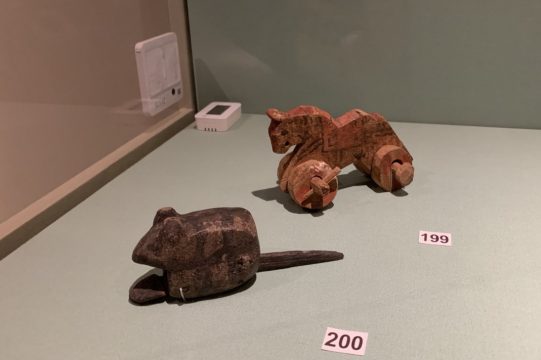
"Rat-shaped toys" "Horse toys with wheels" (C) The Trustees of the British Museum
How did they live and become mummified? While feeling mysterious from the view of life and death and magical relics, it seems to be familiar to somewhere. It can be said that this is a unique exhibition where you can see the life of ancient Egyptians.
Cute things you can meet at the venue
The charm of the ancient Egyptian world is that it is full of unique and adorable designs that attract Japanese people today, such as Egyptian gods such as Medjed, Anubis, and Bastet, and hieroglyphs.
Of course, you can meet them in this exhibition, so I will introduce some photos.
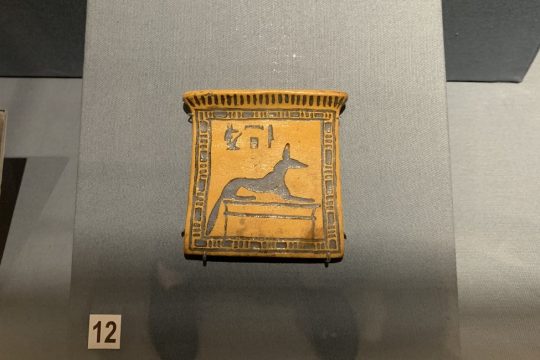
"Pectral" (C) The Trustees of the British Museum
Anubis, the god of mummy making, is a lovely accessory with a figure lying down on the grave. Goods were also made at the special shop at the venue!
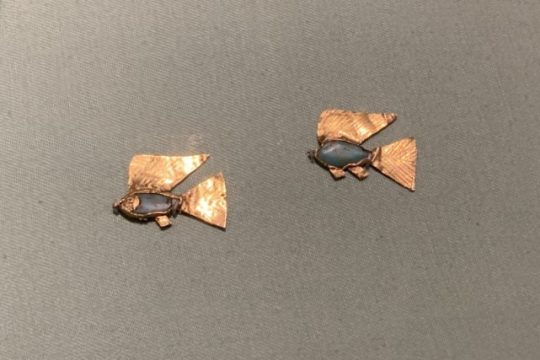
"Fish-shaped amulet" (C) The Trustees of the British Museum
Amulet with a fish motif that symbolizes regeneration, with beautiful gold and blue feldspar. A stylish item with large dorsal fins and tail fins.
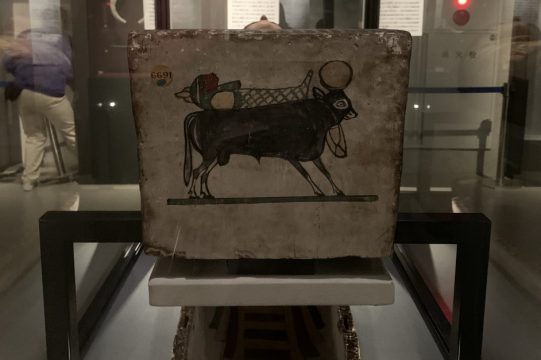
"Takenemet's Inner Coffin" (C) The Trustees of the British Museum
The creature (cow?) Drawn at the foot of "Takenemet's inner casket". Is the round head a corner? Or is it like a ball? I can't say anything about the blurred expression.
Japan original exhibition: Archaeological excavation of Saqqara ruins
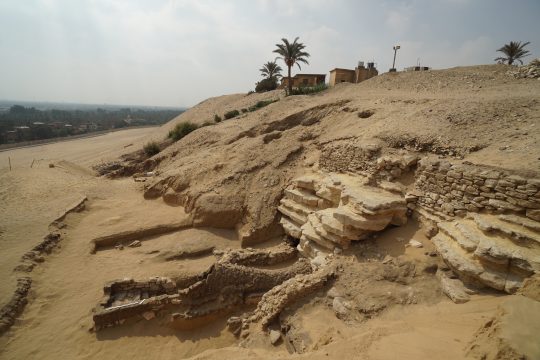
Saqqara Ruins, Roman Catacombs (C) North Saqqara Project
This exhibition is an international traveling exhibition, but in the latter half of the venue, you can also see a special exhibition original to Japan. It is a state-of-the-art excavation survey still being conducted at the Saqqara archaeological site in Egypt.
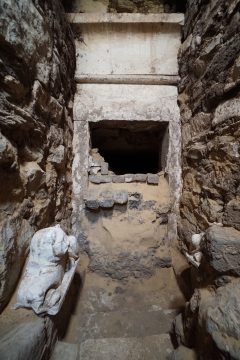
Saqqara Ruins, Entrance to the Roman Catacombs (C) North Saqqara Project
The actual size of the inside of the catacombs (underground mass grave) during the Roman rule, discovered in 2019 by the Japan-Egypt Joint North Saqqara Survey Team, headed by Professor Nozomi Kawai of Kanazawa University, who is the supervisor of this exhibition. Most of them will be introduced in models and videos. I couldn't take a picture, but I was impressed by the attention to detail, such as the decayed atmosphere and the buried bones, that made me feel as if I was actually at the scene.
How were the six mummies that appeared in this exhibition unearthed so that we can appreciate them today? This exhibition should give you an idea of the big picture that wasn't often introduced in the exhibition before.
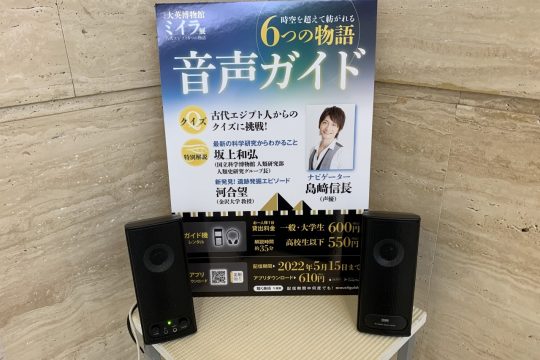
Audio guide with popular voice actor Nobunaga Shimazaki acting as a navigator
If you want to hear the excitement and excavation romance that Mr. Nozomi Kawai felt and want to enhance the sense of reality, we recommend using the audio guide.
Let's smell the mummy

"Cat Mummy" National Science Museum Collection
At the second venue, under the theme of "Ancient Egyptian Civilization and the Japanese," we will introduce how the Japanese learned about the existence of the ancient Egyptian civilization and continued their research. Here, the "Cat Mummy" obtained in Egypt by Masauji Hachisuka, the 18th head of the Awa and Tokushima Domains, is unveiled for the first time.
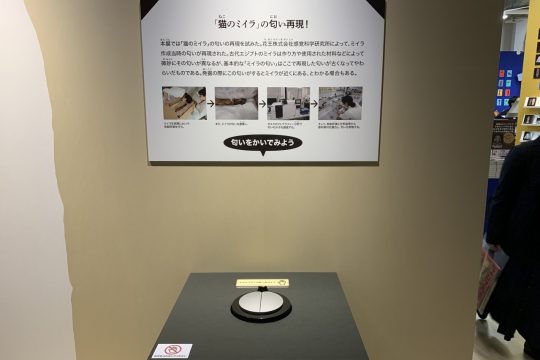
Reproduce the smell of "cat mummy".
In connection with "Cat Mummy", there is also a corner where you can smell the mummy at the time of making it, which was reproduced by Kao Corporation's Sensory Science Research Institute! The chance to smell a mummy is unlikely for the average person, so it's a valuable opportunity.
There is also a special collaboration with "Kaiketsu Zorori"!
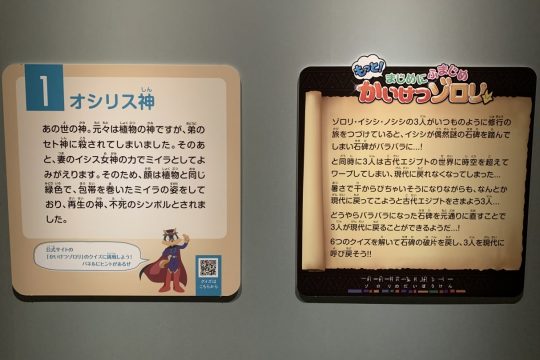
Collaboration panel of "Kaiketsu Zorori" in the venue
In addition, this exhibition attracts the attention of fans by collaborating with the reading series "Kaiketsu Zorori", which is loved by a wide range of generations.
A quiz about the story of rescuing Zorori and others who have lost their way into the world of ancient Egypt and cannot return to the present day is posted on the official website. If you want to watch it with a small child, please try it by referring to the hints on the panel inside the venue. In addition, many "Kaiketsu Zorori" original goods were prepared at the special shop, so fans should not miss it.

There are also sweets from the original package of this exhibition in collaboration with the famous cacao brand "Hotel Chocolat" in England, where the British Museum is located. The design is irresistible and cute.
Outline of the special exhibition "British Museum Mummy Exhibition 6 Stories of Ancient Egypt"
| Legislative session | October 14, 2021 (Thursday) -January 12, 2022 (Wednesday) * The session is subject to change. |
| venue | National Science Museum |
| Opening hours | 9:00 to 17:00 (Admission is 30 minutes before closing time) |
| closing day | Monday, December 28th (Tuesday) -January 1st (Saturday / holiday) * However, the museum is open on December 27th (Monday), January 3rd (Monday), and January 10th (Monday / holiday). |
| Admission fee | General / university students 2,100 yen Elementary / junior high / high school students 600 yen (tax included) * Reservation by date and time is required. * Free for preschoolers. Free for persons with a disability certificate and one caregiver. |
| Organizer | National Science Museum, British Museum, Asahi Shimbun |
| inquiry | 050–5541–8600 (Hello dial) |
| Exhibition official website | https://daiei-miira.exhibit.jp/ |
<Past exhibition report>
[Tokyo Metropolitan Art Museum] "Van Gogh Exhibition: Resonating Souls Helene and Fincent" Venue Report Follow the collection of van Gogh collectors and gems of belief
Click here for a list


